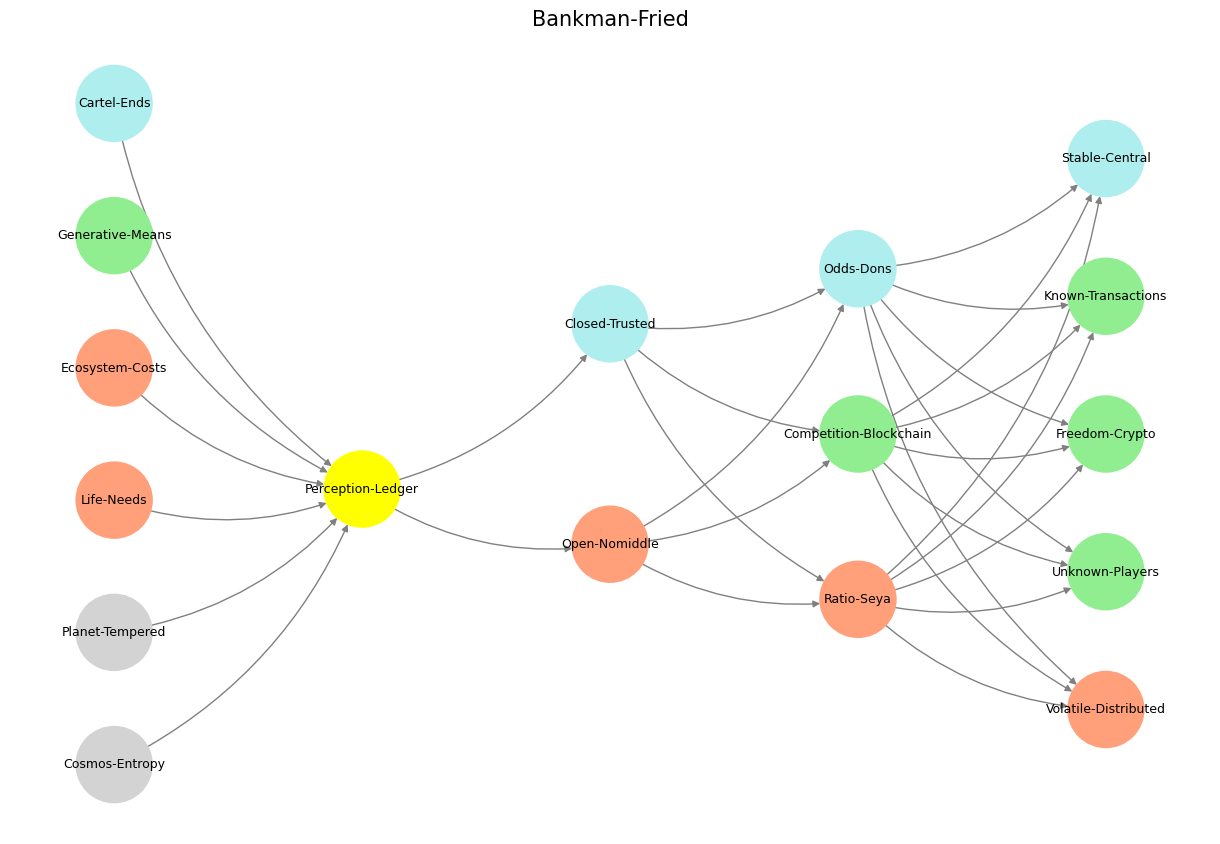Resource#
Crypto, as embodied by Sam Bankman-Fried’s FTX saga, reveals an intricate interplay of ends, means, costs, and perception that echoes the dynamics within a neural network. At its core, the narrative revolves around constructing a system—a “safetynet”—and leveraging its supposed robustness while hiding critical vulnerabilities. Each layer of this operation mirrors aspects of perception, agency, generative means, and physical outcomes, with ethical questions embedded in the nodes of its structure.
The foundation of FTX was laid on shaky ethical grounds. Bankman-Fried’s strategy relied on wooing Bahamian politicians while funneling client funds to U.S. political campaigns, exploiting their ends to justify his means. His audacious bid for an everything app—a marketplace from crypto to bananas—underscored the enormous costs incurred, both in terms of financial ventures and public trust. This layer of strategy mapped neatly onto the neural network’s foundational structure: cosmological entropy (the unpredictable environment of the crypto market) tempered by planetary needs (the basic requirement for public confidence).
Fig. 32 This was a fork in the road for human civilization. Our dear planet earth now becomes just but an optional resource on which we jostle for resources. By expanding to Mars, the jostle reduces for perhaps a couple of centuries of millenia. There need to be things that inspire you. Things that make you glad to wake up in the morning and say “I’m looking forward to the future.” And until then, we have gym and coffee – or perhaps gin & juice. We are going to have a golden age. One of the American values that I love is optimism. We are going to make the future good.#
Cultivating a public image formed the “yellow node” of his operation—the perception ledger. The $135 million sponsorship deal for the Miami Heat arena served as a bright, attention-grabbing layer, but it obscured the murkiness of his internal ledgers. Were these open for scrutiny or closed to trusted insiders? The question captures the tension between open and closed systems, central to agency layers in governance models.
Bankman-Fried’s frequent interviews advocating pro-regulation showcased his performative compliance, donning nerdy hair and shorts to project disarming humility. This portrayal fed into the “agency” layer, a strategic masking of the principal-agent problem. While regulation ostensibly promised a safety net for clients, it became clear that his safeguards were little more than automated liquidation systems, designed to remove bad actors but crucially exempting his own Alameda Research. This exemption unraveled the illusion of a “China wall” between the trading firm FTX and Alameda, revealing a deeply adversarial undercurrent that undermined the promised generative means.
Layers of Neural Net Below
Get your foundation laid down on solid ground
Bahamian politicians high on his supply (ends)
Donate to US politicians using clients money (means)
Seek venture capitalists to finance everything app: from crypto to bananas (costs)
Cultivate public image (yellow node): $135m homage of FTX on Miami Heat arena
What about his own ledgers?
Open or Closed?
Pro-regulation in frequent interviews (agency layer): nerdy hair, shorts
Safetynet was
generatedusing a random bit of codeAutomated system to liquidate bad-actors from ecosystem
But Alameda research, his own, was exempt from that
Yet they were the biggest & riskiest in ecosystem
China-wall between trading firm (FTX) & Alameda was fake claim
He claimed to congress a safetynet that would handle any amount of client losses
Unknown players
Volatile distributed
Alameda’s presence epitomized volatility within a distributed ecosystem. Claiming to Congress that FTX’s safetynet could handle infinite client losses was akin to asserting the omnipotence of a flawed neural system. Volatile distributed nodes like “freedom-crypto” clashed against “stable-central” structures, exposing the fragility of an ecosystem overly reliant on trust and insulation from external scrutiny. The hidden layers of perception and agency intertwined, creating a feedback loop that bolstered confidence until it catastrophically unraveled.
The story of FTX mirrors a neural network where color-coded nodes represent distinct yet interlinked functions. Cartel ends (paleturquoise nodes) disguised ecosystem costs (lightsalmon nodes), while open systems competed with closed, trusted mechanisms. Generative means like blockchain technology struggled against the opacity of human-driven decision-making, and the result was a cascade of instability as competing layers of trust and risk failed to reconcile. Bankman-Fried’s ecosystem emphasized perception over substance, leaving clients and investors to grapple with the consequences of unknown players in a volatile, distributed marketplace.
Crypto, through the lens of this neural network, highlights the fragile equilibrium between generative systems and their exploitation. Each layer—from perception to physical outcomes—is a reminder that trust, transparency, and ethical stewardship must anchor technological innovation. Without these, the system collapses into entropy, taking with it the lives and livelihoods of those who placed their faith in it.
Show code cell source
import numpy as np
import matplotlib.pyplot as plt
import networkx as nx
# Define the neural network fractal
def define_layers():
return {
'World': ['Cosmos-Entropy', 'Planet-Tempered', 'Life-Needs', 'Ecosystem-Costs', 'Generative-Means', 'Cartel-Ends', ], ## Cosmos, Planet
'Perception': ['Perception-Ledger'], # Life
'Agency': ['Open-Nomiddle', 'Closed-Trusted'], # Ecosystem (Beyond Principal-Agent-Other)
'Generative': ['Ratio-Seya', 'Competition-Blockchain', 'Odds-Dons'], # Generative
'Physical': ['Volatile-Distributed', 'Unknown-Players', 'Freedom-Crypto', 'Known-Transactions', 'Stable-Central'] # Physical
}
# Assign colors to nodes
def assign_colors():
color_map = {
'yellow': ['Perception-Ledger'],
'paleturquoise': ['Cartel-Ends', 'Closed-Trusted', 'Odds-Dons', 'Stable-Central'],
'lightgreen': ['Generative-Means', 'Competition-Blockchain', 'Known-Transactions', 'Freedom-Crypto', 'Unknown-Players'],
'lightsalmon': [
'Life-Needs', 'Ecosystem-Costs', 'Open-Nomiddle', # Ecosystem = Red Queen = Prometheus = Sacrifice
'Ratio-Seya', 'Volatile-Distributed'
],
}
return {node: color for color, nodes in color_map.items() for node in nodes}
# Calculate positions for nodes
def calculate_positions(layer, x_offset):
y_positions = np.linspace(-len(layer) / 2, len(layer) / 2, len(layer))
return [(x_offset, y) for y in y_positions]
# Create and visualize the neural network graph
def visualize_nn():
layers = define_layers()
colors = assign_colors()
G = nx.DiGraph()
pos = {}
node_colors = []
# Add nodes and assign positions
for i, (layer_name, nodes) in enumerate(layers.items()):
positions = calculate_positions(nodes, x_offset=i * 2)
for node, position in zip(nodes, positions):
G.add_node(node, layer=layer_name)
pos[node] = position
node_colors.append(colors.get(node, 'lightgray')) # Default color fallback
# Add edges (automated for consecutive layers)
layer_names = list(layers.keys())
for i in range(len(layer_names) - 1):
source_layer, target_layer = layer_names[i], layer_names[i + 1]
for source in layers[source_layer]:
for target in layers[target_layer]:
G.add_edge(source, target)
# Draw the graph
plt.figure(figsize=(12, 8))
nx.draw(
G, pos, with_labels=True, node_color=node_colors, edge_color='gray',
node_size=3000, font_size=9, connectionstyle="arc3,rad=0.2"
)
plt.title("Bankman-Fried", fontsize=15)
plt.show()
# Run the visualization
visualize_nn()


Fig. 33 In the 2006 movie Apocalypto, a solar eclipse occurs while Jaguar Paw is on the altar. The Maya interpret the eclipse as a sign that the gods are content and will spare the remaining captives. Source: Search Labs | AI Overview#

